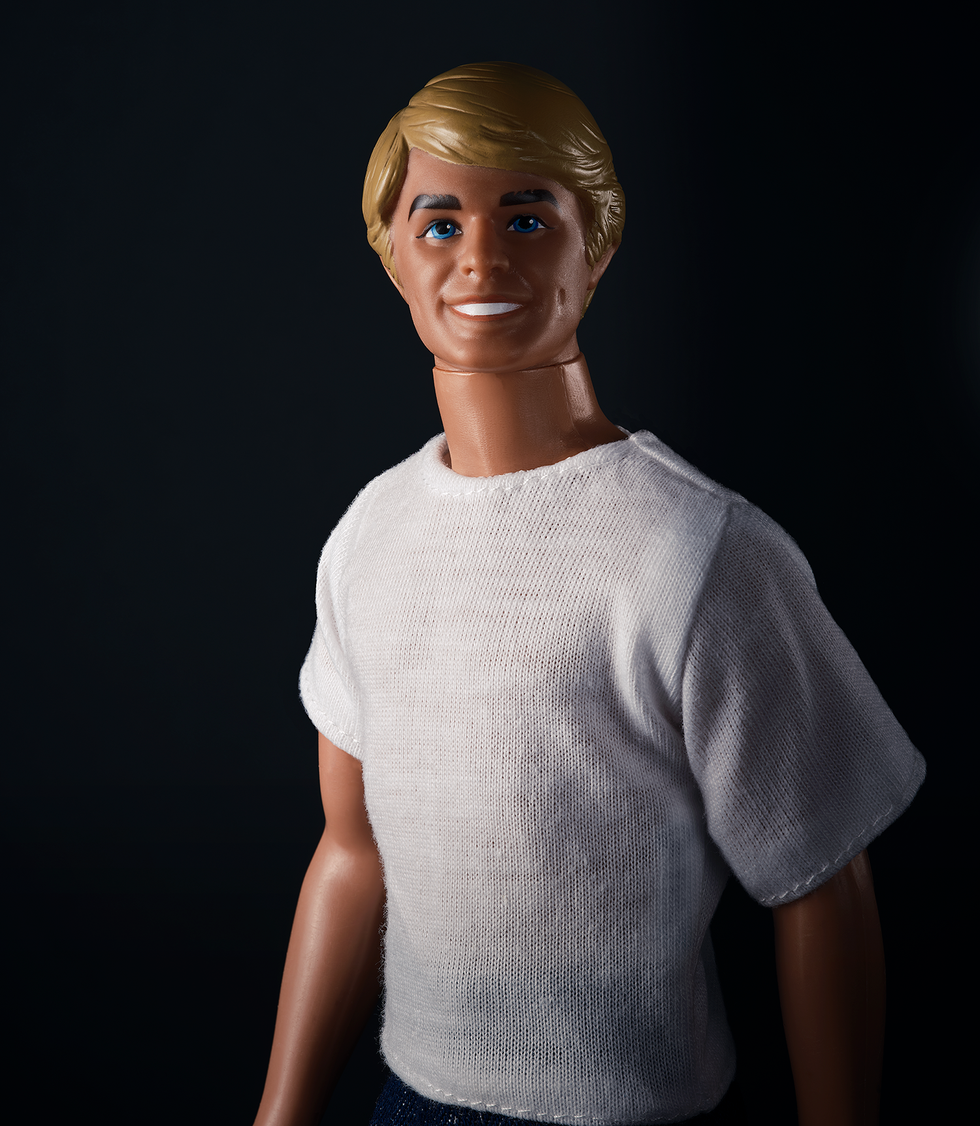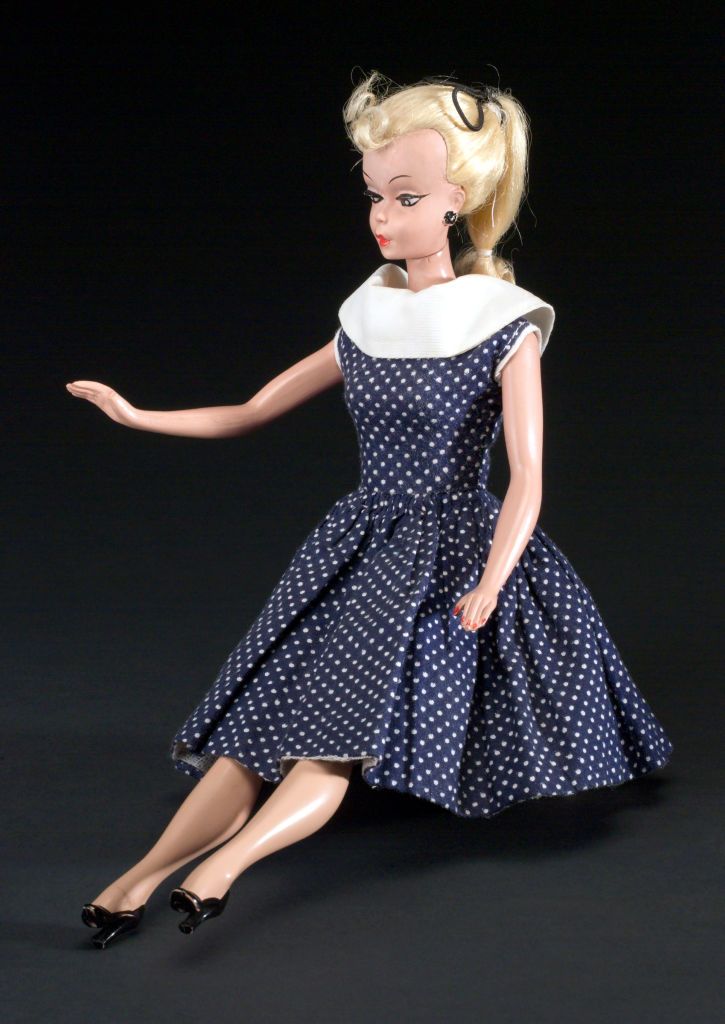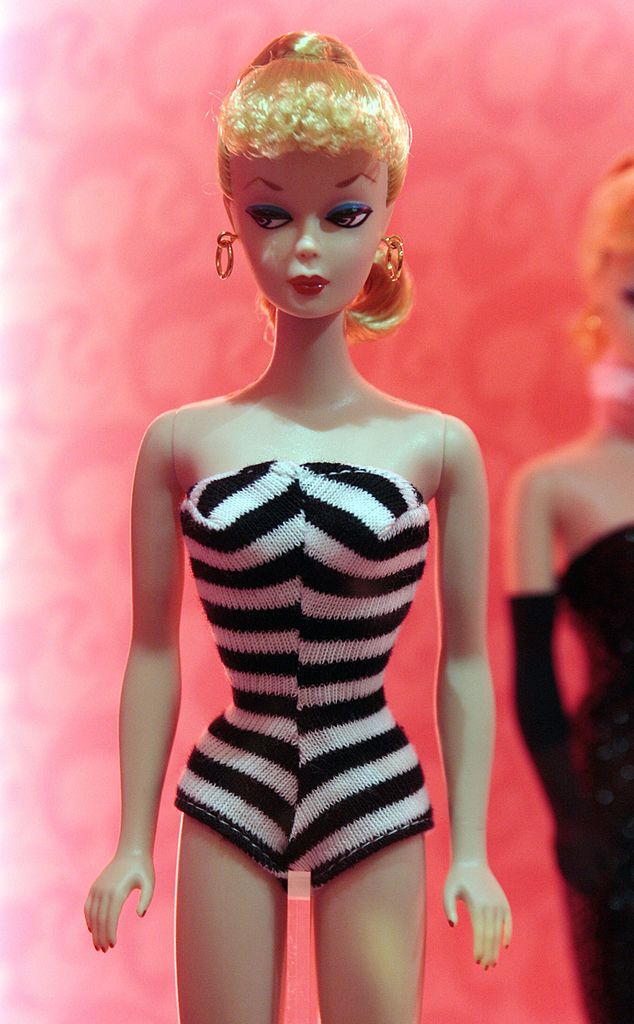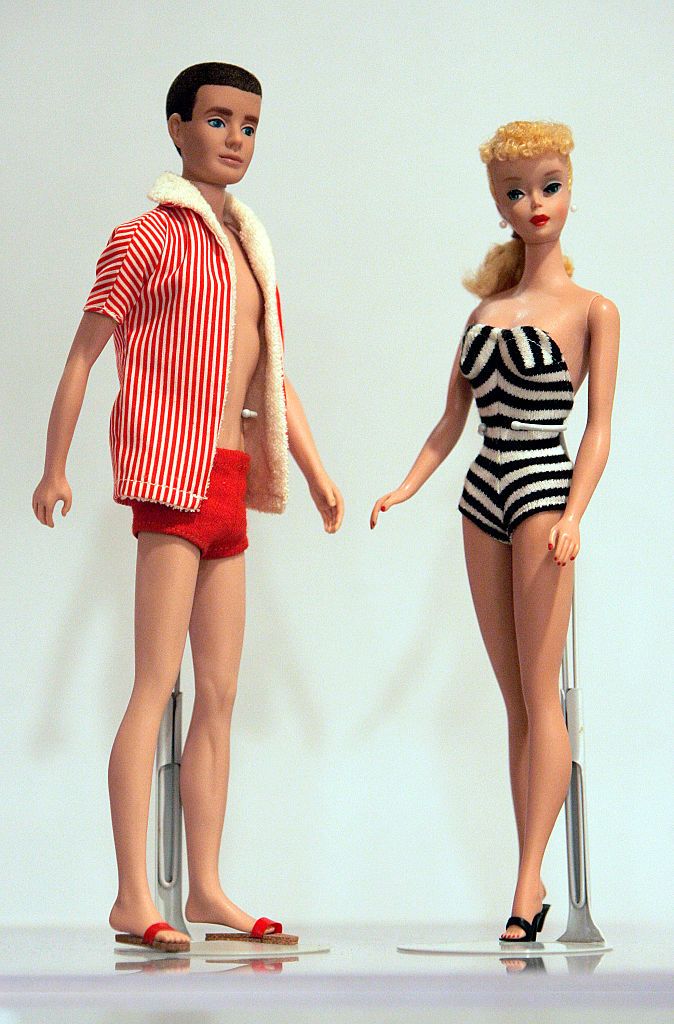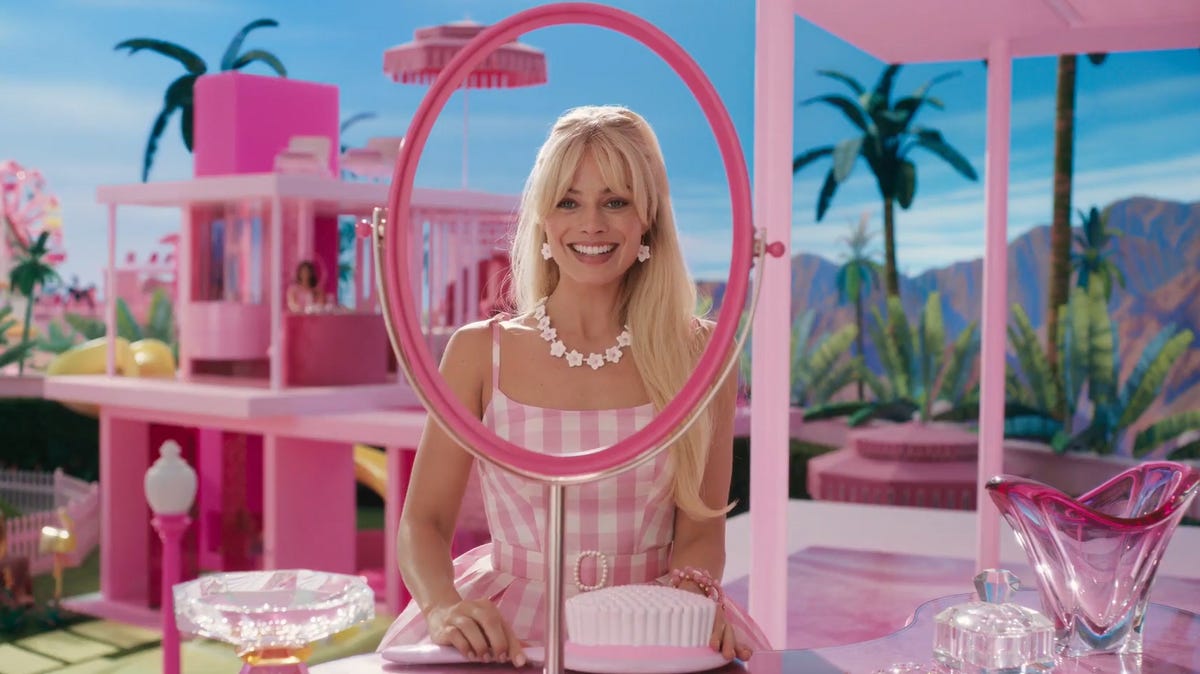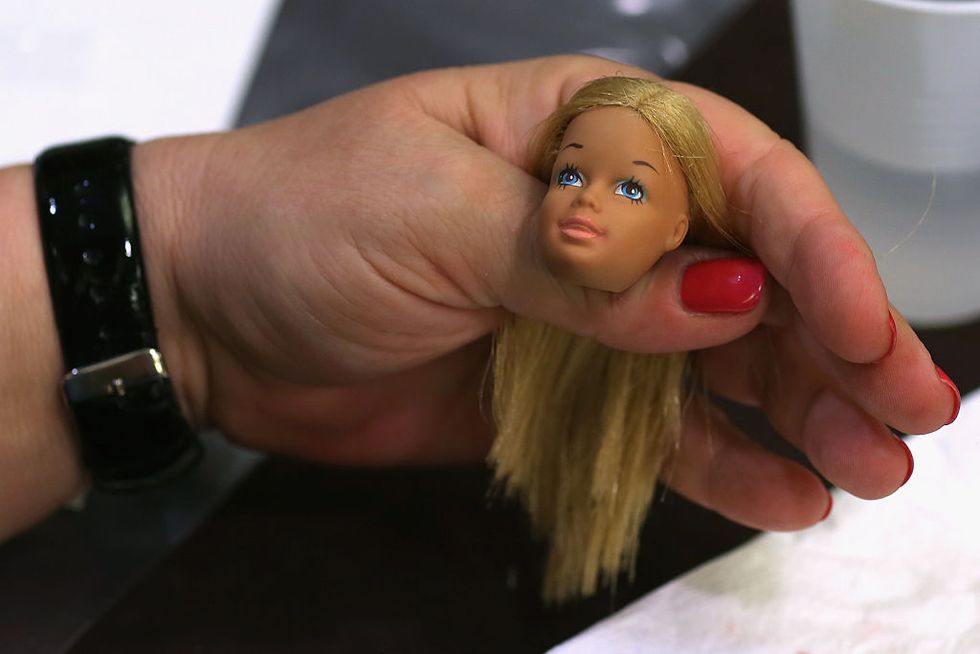On the 4th of April this year, as a former president was quietly getting arrested, the internet went nuts for another all-American male with a penchant for an artificial tan. After much anticipation, Warner Bros released the posters for a new live-action feature film, Barbie, the hot-pink hot-take on the pneumatic fashion doll from director Greta Gerwig, due out this summer. Here, in a pink gingham sundress, sitting in the upper lobe of a giant letter “B”, was the Australian actress Margot Robbie, as the title character; below her, gazing up adoringly, in a fetching green-and-white striped beach-shirt-and-shorts combo, was the Canadian actor Ryan Gosling, as Barbie’s boyfriend. But it wasn’t the picture that launched a thousand memes. It was the tagline: “She’s everything. He’s just Ken.”
Just Ken. The adverb so brutal for being so casual. But we knew who they meant and how they meant it: Barbie’s much maligned “best friend” who has, for more than 60 years (with a small hiatus at the turn of the millennium, which we’ll get to) been by her side, offering her, if not sexual satisfaction (we’ll get to that too), then at least moral support, in cute,
complementary outfits. Ken, who has been through more bodily changes than mid-2000s Christian Bale; Ken, who, in his doll form, has been habitually abused with the mercilessness of a character from a Hanya Yanagihara novel; Ken, who has spent most — no, all — of his existence in the shadow of his permanently tippy-toed better half.
In popular culture, Ken has become a by-word for pathetic, self-denying masculinity; the archetype of a submissive, passive, henpecked milksop, who exists only to hold his girlfriend’s handbag and be gently ridiculed (the memes that followed the poster’s release ran the tagline under photographs of Lady Diana and Prince Charles; Zendaya and Tom Holland; Megan Fox and Machine Gun Kelly). Sometimes not even gently: in Toy Story 3, Ken’s most high-profile cinematic role to date, in which he attempts to assert himself by joining forces with an evil teddy bear, he suffers the indignity of being dressed down by a root vegetable: “You ascot-wearing pink-noser! You’re not a toy, you’re an accessory! You’re a purse with legs!” says Mr Potato Head (himself a bowler-hat-wearing tuber, with legs). But while we can all say we know Ken, do we know him?
To learn about Ken you must first learn about Barbie because, in their genesis story, man was created for woman. There are books called things like The Good, the Bad, and the Barbie: A Doll’s History and Her Impact on Us, and Barbie and Ruth: The Story of the World’s Most Famous Doll and the Woman Who Created Her that will give you her backstory, the gist of which is this: in 1956, while on a family vacation in Switzerland, Ruth Handler — who, with her husband Elliot, ran Mattel, a toy company in California, whose biggest success to date had been something called a “Burp Gun” — had a fateful encounter with a sexy doll called Lilli.
Lilli was a doll for men, a novelty gift based on a cartoon character from the German tabloid, Bild. She had the body of an adult woman — albeit it one with impossible proportions — and a range of saucy outfits into (and out of) which she could be slipped. Handler saw the potential, in a market hitherto supplied only with baby dolls, of a toy onto which girls could project their grown-up future selves. In 1959, after suitable refinements were made to the first Japanese-produced prototypes, including filing off the doll’s protruding nipples (and, later, fending off two copyright lawsuits from the original German manufacturer), Barbie Millicent Roberts was let loose on the world.
You’ll have a sense of what happened after. How she became a phenomenon: supposedly hated by mothers, adored by little girls (and, yes, some little boys too); celebrated for empowering her owners to feel — back when it was still a ludicrous idea — that they could be both a business hotshot, a TV star, and President of the United States; chastised for reinforcing an archetype of extreme feminine beauty that was both dangerous and impossible to attain. And, for the sensibilities of the era, there was another problem. “Barbie taught girls what was expected of women,” writes MG Lord in Forever Barbie: The Unauthorised Biography of a Real Doll, “and a woman in the fifties would have been a failure without a male consort, even a drip with seriously abridged genitalia who wasn’t very important in her life.”
Mattel, in fact, was said not to have wanted to make a boyfriend for Barbie, but eventually succumbed to consumer pressure. Thus, two years later, in 1961 — on 11 March or 13 March, no one seems exactly to know, or possibly, care — Kenneth Sean Carson was born. Just as Barbie had been named after the Handlers’ daughter, Barbara, Ken was named after their younger son: a fact which perhaps adds an extra weirdness to the couple’s romantic status. The first Ken doll was boyishly handsome, athletically trim, and he came with cute red swim-shorts, tiny plastic sliders and a sherbet-yellow beach towel.
There was one thing that Ken didn’t come with, and beyond his girlfriend, it is probably the thing — or lack of a thing — for which he is best known. The story goes that both Ruth Handler and Charlotte Johnson, the New York designer who oversaw Barbie’s wardrobe, advocated for Ken to have, if no actual penis, then at least a “bulge” in his trousers; the squeamish male executives at Mattel did not. The women won out, but, like Barbie’s nipples, not without some modifications: it became apparent that, unless reduced to pre-emptively modest proportions, Ken’s smooth plastic groin, once covered with fabric and fastenings, could acquire problematic heft.
(On the subject of The Absent Penis, MG Lord’s book takes a deep dive into the Freudian symbolism of Barbie and Ken’s accessories which, though perhaps stretched at times, is too fun not to repeat. Ken’s outfits, she observes, often come with conspicuously phallic accoutrements, such as a baseball bat, a rifle, or a “pendulous stethoscope”. “The cruellest comment on his genital deficiency, however,” she writes, “came in 1964, with ‘Cheerful Chef’, a backyard barbecue costume that included a long fork skewering
a pink plastic weenie […] The seeming deliberateness of these symbols makes it hard to interpret Ken’s sad, solitary sausage as innocent. Likewise, the message on his apron — ‘Come and get it’ — seems a bitter taunt about the genital he will never possess.”)
Ken’s role was predetermined, then, and has changed little since (with the exception of a hiatus in their relationship between 2004 and 2011, during which Barbie briefly shacked up with an Australian surfer doll called Blaine). He is Barbie’s toyboy boy-toy: her faithful companion, her arm-candy, her cheerleader and, when the mood takes her — though Barbie had a bridal look before Ken was even invented — her virgin groom. He’s had plenty of professions of his own, including doctor, astronaut and — praise be! — barista, yet he appears to remain something of a kept man. Barbie’s Dream House has been through countless iterations; Ken has never had a home of his own, having had to make do with sleeping in the backseat of the Ken Dream-Vette or, more likely, a shoebox.
His look, however, has been through many changes, encompassing new faces, hair styles and body shapes, including the significant beefing-up he received in the late 1960s; over the years, in a bid to broaden their appeal beyond the starkly Teutonic, he and Barbie have been made available in a variety of ethnicities, most recently the 15 new dolls issued by Mattel in 2021, in which he was produced in various skin tones and with an optional
man-bun. (He also unwittingly spawned the phenomenon of the human Ken Doll — men with a pathological commitment to plastic surgery which is all too depressing to get into.)
Even when this magazine reported on the launch of the 2021 Ken range, he was referred to as an “unlovely icon of modern American anti-style” and compared, again, to Donald Trump. MG Lord, though, is unflinching. “Just as the goddess-based religions antedated Judeo-Christian monotheism,” she writes, “Barbie came before Ken. The whole idea of woman as temptress, or woman as subordinate to man, is absent from the Barbie
cosmology. Ken is a gnat, a fly, a slave, an accessory of Barbie. Barbie was made perfect: her body has not evolved dramatically with time. Ken, by contrast, was a blunder: first scrawny, now pumped-up, his ever-changing body is neither eternal nor talismanic.”
And all the guy had to do was be conventionally handsome, mysteriously rich, and nice to his girlfriend. Poor Ken.
It is when he is in doll form, however, that Ken receives his cruellest abuses. And though it felt like initiating some kind of miniaturised version of the Stanford Prison Experiment, I felt I should bear witness. On eBay one day I made the first — and, as it turned out, only — bid on a “1980s Ken” whose photograph showed him in a sleeveless tuxedo jumpsuit. I paid £5, with £2.75 shipping, and worried that I might have been stung (the seller later refunded me the postage, after noticing Ken had a “rip in his trousers”). When the box arrived, I couldn’t bring myself to open it. It was all too clear what was coming.
Eventually, though, I summoned my daughters.
“UUUUUGGGH,” said the nine-year-old, as she pulled Ken from his bubble-wrap sheath, his glistening smile unrequited. “Why did you buy that?”
The seven-year-old smelled blood. “Nice sparkly trousers, mate.”
Within a minute, they had flipped him over and stripped him naked.
Their father leaned over. “Nice butt cheeks,” he said, wistfully.
“He’s got no penis,” said the nine-year-old. “WHY?”
“It would get snapped off?” offered the seven-year-old. (Somewhere in the Vatican, the Belvedere Apollo nodded sadly.)
Two minutes in, Ken had been relieved of his right arm. “It was an ACCIDENT,” said the nine-year-old.
After three minutes, they’d left him face-down on the table and returned to Sharpie-ing their bedroom walls. The fun, such as it was, was over.
It was behaviour that has been repeated since Ken’s very beginnings. This one was just lucky there were no Barbies lying around, with whom he might have been forced into unspeakable acts. But how, I wondered, did my daughters know? Did they have some instinctive sense that Ken was subverting the conventions of hegemonic masculinity that they, their tender identities already crushed beneath the wheels of patriarchal society, had unwittingly internalised? Did that same interior sense of their own real-world gender subjugation make them want to take one of the dwindling opportunities available to them to ruthlessly dominate an unfeasibly small, fragile male? Or did they just think his trousers were stupid?
And how universal was this phenomenon? Surely out there in the world — if only by dint of the law of averages — there were some in Ken’s corner? I searched the internet for signs of fandom. Twitter and Instagram were stymied by the fact that American rapper Ken Carson has bagged the key handles. I scoured Barbie’s Instagram for a less obvious Ken handle I could have missed, but she only followed Thomas the Tank Engine (the hussy!). I joined some private Facebook groups, featuring boy dolls in skimpy home-made outfits, but I wasn’t sure that was the kind of enthusiasm I was looking for. Even Reddit — which has discussions on “What is the singular form of ‘spaghetti’?” and “When’s the last time you dusted your ceiling fans?” — was a Ken wasteland.
For all the publications extolling the seismic impact of Barbie, there is just one single book — just the one — about Ken. It’s called I Heart Ken: My Life as the Ultimate Boyfriend, and it is written by Ken himself, though “told to Jef Beck” (also just the one). It is not an autobiography, but a guide to impressing girls, Ken-style, in which he shares advice such as “Try matching your tie or cummerbund to her skirt”, and “Adopt a dolphin”. The author biography revealed that Jef-with-one-f lived in Cedar Rapids, Iowa, and was the owner of “the largest Ken doll and Ken doll fashion collection in the United States”. He also ran a website called Keeping Ken, which chronicled the doll’s history, and had advised on Ken’s outfits in Toy Story 3. Surely, if anyone would go to bat for the little fellow, Jef-with-one-f was the one?
But, sadly, my search went nowhere. Keeping Ken didn’t seem to have been updated since 2013, and the email I sent bounced back. The publishers of I Heart Ken didn’t respond, and, as the weeks ticked by, the Facebook message I sent to a person I thought could be Jef remained unanswered. Then, to my horror, I realised that it was 10 March. Nearly Ken’s maybe-birthday! Again, I scoured the internet: surely there would be a celebratory Zoom chat somewhere, or maybe even, I dared to dream, a small gathering in a Best Western? (Barbie’s 50th birthday in 2009 was marked by a special runway show at New York Fashion Week, and a party at a real-life Malibu Dream House, overseen by interior designer Jonathan Adler; when interviewed by Today.com, Adler was asked about the whereabouts of Ken. “Ken’s around, but does she need Ken?” Adler replied. “No.”) I found nothing. It seemed that Ken’s 62nd birthday — whenever it really was — would be going unmarked.
So on 13 March, we threw our Ken a party. We set up some Ken-sized lounge furniture, and a disco light, and put out some light snacks. The nine-year-old made him a tiny paper hat, and a birthday cake punched out from a stale biscuit, and we lit him a candle. But soon, I could feel my daughters losing interest (their father, from the other room, had already shouted “You’ve gone mad”), but I cajoled them into a lacklustre rendition of “happy birthday” before they drifted back to the TV, and Ken, grinning and lonely in the flickering disco light, was abandoned once more.
Honestly, it was all looking pretty bleak. But then, Jef replied.
Jef Beck — who married his partner, Matt, in 2016, and now goes by Jef Beck-Skoglund, hence my inefficient attempts to Jessica Fletcher him — was introduced to Ken on Christmas Day in 1970. His parents had bought the doll as a present for one of Jef’s older sisters, but when Jef laid eyes on him, the connection was immediate. It was the “New Good-lookin’ Ken”, who came dressed in a yellow T-shirt, open to the navel, and a pair of multi-coloured surf shorts, the label on the box advertising his “Bendable legs!”
“It kind of became my doll; I took it over,” says Beck-Skoglund, on a Zoom call from Texas, where he and Matt now live. His parents, he says, had noticed his interest in his sisters’ dolls, but bought him male figurines aimed at boys, like the Six Million Dollar Man doll, or another Mattel line of the 1970s and 80s (which, in retrospect, looks like it might have been conceived by Tom of Finland) called Big Jim. “I think they were just doing their best to guide me, and to not have kids make fun of me,” remembers Beck-Skoglund, who has neatly trimmed grey hair and looks youthful for his 58 years, but “there was just some kind of thing about Ken.”
Ken gave him an entry point to play with his sisters and “join this little secret society they had in their bedroom”, but — despite getting teased by neighbourhood kids — there was a deeper bond, too: “I looked at him as the perfect boyfriend, you know? Who had a lot of good qualities that I wanted to have when I grew up. So that’s the connection I have, but
everyone has a different type of connection to him. I think you should be able to project whatever you want Ken to be.”
In 1999, after a spur-of-the-moment nostalgic eBay purchase, Beck-Skoglund decided to start collecting. In 2001, he attended his first National Barbie Doll Collectors Convention, and was shocked to discover that of the 850-or-so enthusiasts assembled, “maybe three would specifically collect Ken”. When he told another delegate of his collecting plans, they replied, “You’re wasting your money.” Beck-Skoglund’s resolve was only strengthened. “OK,” he thought, “well let’s get him noticed then.”
Beck-Skoglund meant business. His website, which he admits he’s neglected of late (“life gets in the way”), lists every Ken produced until 2011, most of which he has at some point owned; when we speak, he and Matt are in the process of moving home and Beck-Skoglund is surrounded by stacked boxes of his collection. “When we looked for a house this time we looked for a three-bedroom,” he says. “One as a guest bedroom, one as a master bedroom, and one is just the doll room.” Chronicling Ken through the years, he says — and, men’s style magazine reader, take note — provides “a history not only of the doll, but of the times and what was going on; you get this picture-portrait of fashion all the way from 1960s to the current day”.
Let’s just say that his archive contains some doozies. There’s 1978’s “Sun Lovin’ Malibu Ken”, who, beneath his high-cut aqua trunks, has actual tan lines. There’s “Animal Lovin’ Ken” from 1988, who has a blue leopard-print shirt, silky scarf, and comes with a pet chimpanzee. There’s the infamous “Earring Magic Ken” of 1991, who wears a purple mesh belly top and has a pierced left ear — and perhaps most pertinently, wears on a chain around his neck what has been interpreted by some to be a cock ring — who should in no way be confused with 1993’s “Camp Ken”, who was in fact a rugged outdoorsman (“his backpack turns into a sleeping bag with glow-in-the-dark stars!”).
To make a splash for Ken’s 50th birthday in 2011, Beck-Skoglund “ghost-wrote” I Heart Ken (even in Ken’s one and only book, Barbie still writes the introduction). Sadly though, when Ken’s 60th rolled around in 2021, it was peak pandemic, and the National Barbie Doll Collectors Convention at which he might have been celebrated was held online. Between 2012 and 2015, Beck-Skoglund even ran an alternative Ken-themed event, called Kenvention (I know! Too good!), which attracted as many as 150 attendees, but when he moved to Texas there were quibbles about location and Kenvention (I know! Still good!) ran out of steam.
At times, being a Ken devotee is a solitary business. Beck-Skoglund has met other Barbie collectors who collect Ken on the side, but knows no others who are devoted to him exclusively. “I’m one of a kind, I guess,” he says. But he has plans: in 2024, the National Barbie Doll Collectors Convention will be held in Palm Springs, California, and Beck-Skoglund, who retired four years ago from a career in fashion retail in which he managed several Gap stores, will be the chair: “I am finding ways, even though it’s a Barbie convention, to throw some Ken stuff in there. I think people expect that from me; no one’s going to be surprised if I represent him in the centrepiece somewhere…” If it goes well, maybe he’ll go all out in 2026, when Ken turns 65. “If I’m still alive by then,” he says. “I’m looking forward to doing something again in a big way. It’s a lifetime commitment for me.”
But perhaps the Kenaissance will happen sooner than Jef could dare hope. On 4 April, the same day the poster was released, the first full trailer for Gerwig’s Barbie came out too. It was hard to tell from it quite what awaits Ken — since the film was first announced way back in 2009, its plot has been zealously guarded — but in February, a couple of audience reactions from a test screening in New Jersey were published on the website worldofreel.com. Gosling, according to one anonymous audience member, is “a huge scene stealer” in what is “perhaps his best performance”. Another describes him as the movie’s “MVP” and predicts his scenes “will be memed to death”.
Maybe this Ken really is going to take pride of place in the centrepiece. From the brief shots of Gosling flaring his nostrils and generally huffing about, it does seem that Ken (meaning, again, Gosling’s Ken: the trailer revealed he won’t be the only Ken, nor will Robbie be the only Barbie) might be going through… something. He seems out of sorts. Not content with his lot. Is there some residual testosterone bubbling in his genital bulge? Is he having an existential crisis? Is he starting to wonder, in the depths of his dark, hollow insides, if being “just Ken” is enough?
It’s a destabilising thought; for it is, after all, Ken’s submissive nature that makes him, like Barbie herself, a potentially progressive figure. That he’s got all the gifts (or, as previously discussed, most of them) and is still happy to play second fiddle to his even more accomplished partner. That he understands and values himself as the accessory he undoubtedly is; as Barbie writes in the I Heart Ken introduction, “Most guys would be intimated to have a celebrity girlfriend. Not Ken — in fact, his chill attitude keeps me grounded.” “Just” means “only”, but it also means “absolutely”: it is the essential just Ken-ness of Ken that makes him Ken in the first place.
Beck-Skoglund, who, unlike with Toy Story 3, was not tapped for intel by the makers of Barbie, is still excited to see it. He isn’t too concerned about Ken having a grand guignol; he’s simply glad he made the cut: “I’m just excited that they’re including him in the movie; that he’s an important character in her life.” But, if you ask Jef, he does have a wish for how things turn out for Ken. “I hope he’s a good boyfriend to Barbie,” he says. It’s both a simple ambition and, also, everything. ○

Miranda Collinge is the Deputy Editor of Esquire, overseeing editorial commissioning for the brand. With a background in arts and entertainment journalism, she also writes widely herself, on topics ranging from Instagram fish to psychedelic supper clubs, and has written numerous cover profiles for the magazine including Cillian Murphy, Rami Malek and Tom Hardy.
